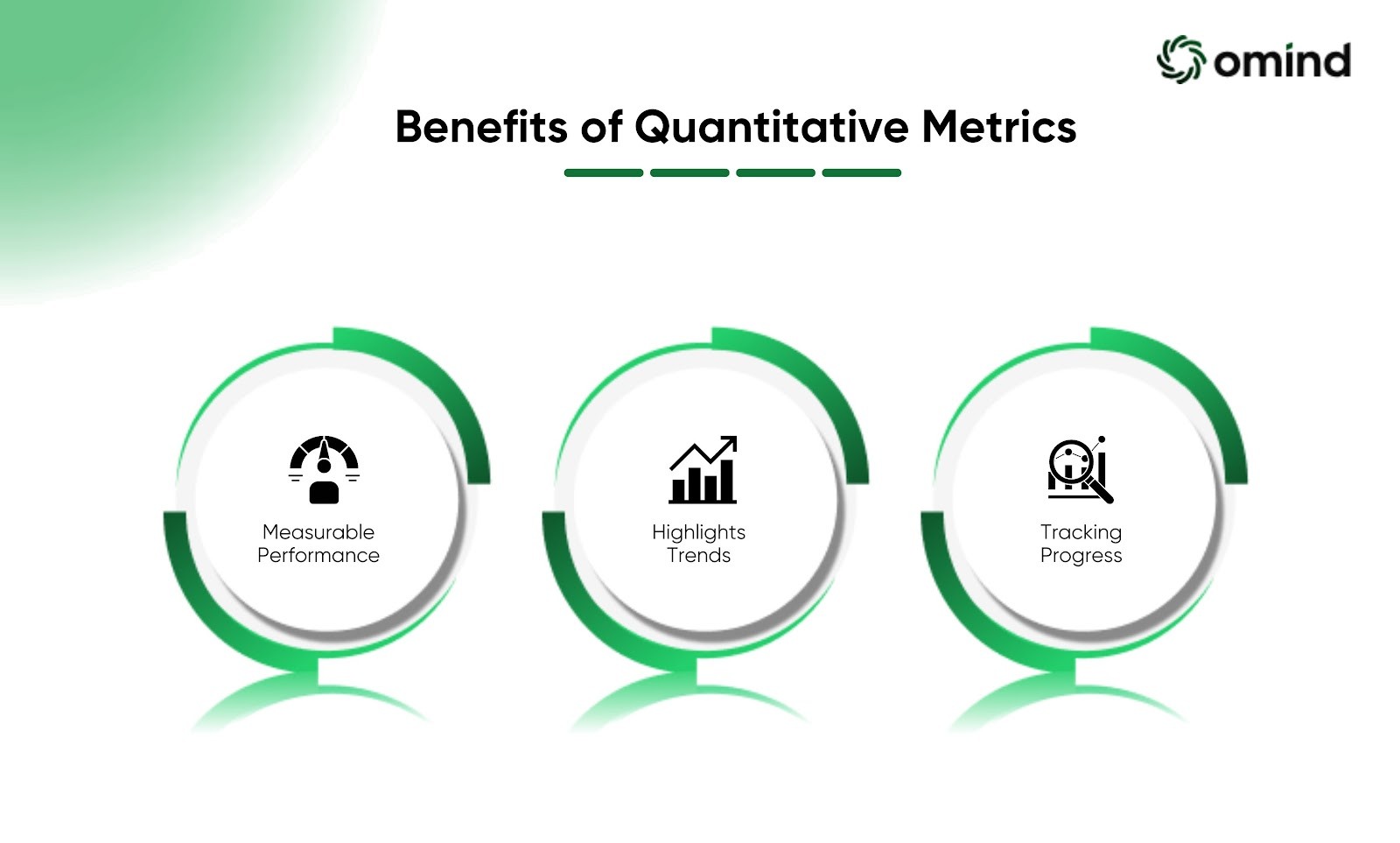Numbers tell a story but may not always get the whole picture. But, metrics provide a clear picture of what's working and where you have problems, helping you make important decisions. Both qualitative and quantitative metrics are part of this process. Quantitative metrics, like sales figures or website traffic, give you complex numbers that show your progress measurably, whereas qualitative metrics, like customer feedback or employee satisfaction, offer insights into the experiences behind those numbers. Both metrics provide a comprehensive view, assisting businesses in making better decisions.
Let's dive into how both kinds of data can help you make smarter decisions.
Understanding More About Quantitative Metrics
This is all about numbers and telling your business story in black and white. It gives you hard facts like sales figures, customer counts, website traffic, etc. When you have them in your hand, you can easily measure and compare them and get a clear snapshot of your business's health.
So, what do you do with these numbers? Now, a business can quickly see how well your business is performing. Use these metrics to identify strengths and weaknesses within your business operations. Quantitative metrics are a roadmap for success and understanding your business performance. However, the numbers may not give you a clear picture. But, with qualitative metrics, you can comprehensively understand your business and make informed decisions.
Now, explore more about the advantages of qualitative metrics.
Benefits of Quantitative Metrics

Give Measurable Performance: Through this method, a business gets concrete data points that allow it to assess the performance accurately. Tracking key metrics like sales figures, customer acquisition costs, and return on investment (ROI) makes it easy to see achievements, identify trends, and make data-driven decisions.
Highlights Trends: Trends are always changing, but uncovering them is easy with accurate data. This information empowers you to compare your results against industry benchmarks and identify growth opportunities. For instance, tracking website traffic and conversion rates helps optimize your marketing campaigns. Omind can simplify this process by offering real-time data analytics and trend identification.
Tracking Progress: Quantitative measures are essential for ensuring your business goals are clear and attainable. Setting clear goals is better for tracking progress and getting a good idea of how your team is doing. This data-driven method ensures you regularly assess and align your work with your business objectives.
But what exactly are the perks of these number-driven metrics? Let's break them down.
Understanding Qualitative Metrics
Qualitative metrics focus on the subjective, non-numerical side of data. They are more interested in opinions, feelings, and experiences than numbers. Think of them as the stories behind the numbers. Examples include customer satisfaction levels, employee morale, and brand perception. They are essential for understanding the human element behind your business performance.
This metric comes from various sources, such as customer reviews, employee interviews, and social media comments. These insights help you dive deeper into understanding customer needs, employee motivations, and overall brand perception. So you can uncover hidden opportunities and challenges that will assist you in succeeding in your business.
Benefits of Qualitative Metrics

Deeper Understanding: Having this method provides a rich context for your quantitative data. Unlike other metrics, it offers a clear "why" behind the numbers. For example, high customer satisfaction scores combined with positive feedback show the reasons for customer loyalty.
Uncovering Insights: Qualitative data give clarity on the factors influencing your performance metrics. Here, you can analyze customer feedback, identify areas for improvement, uncover unmet needs, and discover new opportunities. Omind's experience management platform can help you extract these insights effortlessly.
Human Perspective: Qualitative metrics assess the human element of your business to offer valuable insights into customer experiences, employee motivations, and brand perception. This information is essential for building strong relationships, improving customer satisfaction, and developing a positive culture in your organization.
Okay, let's add color to those black-and-white numbers with a deeper look at qualitative metrics.
Balance Between Quantitative and Qualitative Metrics
Understanding the complete picture of your business requires a combination of two metrics. Quantitative and qualitative metrics give you a full view of your performance.
Quantitative Data: Numbers provide a clear but partial picture of your business performance. So, quantitative metrics are the concrete evidence of your business performance. Now, you get details of key indicators like sales, website traffic, and customer acquisition costs. They are essential for tracking performance, setting goals, and making better decisions. Using Omind, companies can combine quantitative metrics seamlessly for a more accurate performance review.
Qualitative Insights: The numbers are good but only tell one part of the story. You don't get why it is happening behind the numbers. The subjective parts of your business are part of qualitative measures. Customer surveys, employee interviews, and market research reveal how clients perceive your brand, employee job satisfaction, and other subjective insights. These qualitative insights make the quantitative numbers more useful.
The Complete Picture: If you are a business person looking for a complete picture, use quantitative and qualitative data. Quantitative metrics are a foundation, while qualitative metrics add depth and context. Combining these two perspectives allows you to identify trends, understand customer needs, and drive growth.
Now, how do we bring it all together? Let's explore the balance between numbers and narratives.
Integrating Both Metrics for Comprehensive Evaluation
An effective evaluation needs a holistic view. You can combine quantitative and qualitative data to gain a deeper understanding of your performance.
Connecting quantitative and qualitative metrics is better for a holistic view. Numbers act as the backbone, while insights add more depth. For example, high sales figures combined with positive customer feedback. It explains that you have a successful product launch. Together, the result will be more accurate and understanding.
This combination fuels better decision-making. Omind's solutions can facilitate this integration, making it easier to drive growth. Understanding the "what" (numbers) and the "why" (insights) allows you to swiftly identify opportunities, address challenges, and drive sustainable growth. For example, a decline in sales with negative customer feedback might tell you the problem with the product.
In the subsequent section, let's discuss about which metric is better.
Which Metrics Matter More?
You may wonder which one is more essential. Quantitative and qualitative metrics are vital for a comprehensive understanding of your business. They don't work against each other; instead, they work together to give a bigger picture.
A balanced approach like this gives companies detailed insight into performance. Quantitative metrics go with the numbers, giving outcomes like sales, revenue, and customer acquisition costs. On the other hand, qualitative metrics move a little further and reveal the emotions, perceptions, and experiences that drive those numbers. They work together to give transparent information.
Conclusion
Having the right balance between quantitative and qualitative metrics is vital for effective performance evaluation. Combine these two perspectives to gain a deeper understanding, identify areas for improvement, and make decisions that assist your business. Following a data-driven approach empowers organizations to allocate resources efficiently, refine strategies, and achieve sustained success.
If you want to explore quantitative metrics and use cutting-edge technologies, consider Omind, a master in the art and science of metrics. Omind helps companies integrate qualitative and quantitative data and gives actionable insights. Are you ready to know more? Click this link to learn more about Omind's experience management solutions.
AUTHOR
Team Omind
Empowering Businesses with Unified Customer Experience Platform, Leveraging Advanced AI and Intelligent Automation
PRODUCT
Unified CXM
Share LINK
Related Blogs




